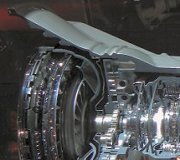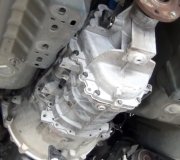No need to rebuild the transmission. It's doing what they do. It might have acted differently right after you bought it because the battery was likely disconnected to replace it or perform some other service. The computer defaults to the factory pre-programmed shift characteristics, then updates based on your driving habits and to match the amount of wear in the clutch packs. A lot of Fords have a very irritating characteristic where the Engine Computer reduces engine power every time the transmission upshifts, presumably to reduce the stress on the transmission because it's so weak, it can't handle normal engine power. I've heard other manufacturers are doing the same thing but I haven't driven any of those. That makes it feel like the engine is stalling.
I get the impression you haven't bought a newer car for a while. It's true we do have the ability to build very high quality cars because we have better metal alloys and very precise robotic assemblers, but common sense has gone out the window with ALL brands because customers demand a lot of "toys" and the manufacturers have convinced us we need that stuff. My '88 Grand Caravan is still my daily driver. It was really cool when it was new because it had all kinds of neat stuff like power windows and electric side mirrors. Today people consider those things to be necessities along with remote starters and seat warmers. The difference is to make dome lights that slowly dim out or to have heaters that make her two degrees warmer over there than him over here requires computer modules. They are extremely unreliable, complicated, and expensive to replace but every manufacturer uses them. That is the single reason I will never buy another new car.
In the 1960s and 70s, even in the 1980s we would never dream of complaining about wind turbulence from windshield wiper arms. Today a car is considered to be of poor quality if you can hear the wind going over the side mirror. The late '90s Caravans were thought to be low quality because of the trouble they had with their turn signal switches. What people didn't realize was there were three different part numbers on the part. One was the Chrysler number and one was the Toyota number. Owners will overlook a problem if it's on a Toyota but condemn the whole brand if that same part has a problem on a Chrysler.
If we would use today's manufacturing techniques and computer-aided design to build a 1970s model car, there would probably not be a single breakdown in the first 100,000 miles. You would not have power windows, locks, or mirrors. The heater would blow 100 percent of the air onto the windshield or your feet, and maybe half and half, but certainly not 20 percent on the windshield, 20 percent on your face, 50 percent on your feet, and 10 percent on the side windows, all at the same time. Your but t would be cold for the first few seconds after sitting on the vinyl seats because, after all, it's winter outside and you expect to be cold. No doors that lock by themselves because we're to stupid to push a button when WE want the doors to lock. Today's cars are much cleaner out the tail pipe, and I doubt many people want to go back to the old days, but my 1980 Volare consistently gets 28.3 mpg. That's a 4400 pound car with chrome steel bumpers. At half the weight today, a little Neon with styrofoam bumpers, (that is not sarcasm), can only get 33 mpg. I'll win in a crash! Why is it that a 1968 Buick Wildcat was so huge, you needed binoculars to look in the mirror to see the tail lights, but they got 23 mpg, in comfort?
You must also remember that labor costs and benefits to build a car are much higher than in the past. Here the government and businesses are adversaries. In Japan the government's attitude is "how can we help you be more competitive"? Management people in Japan earn about twice that of an assembly line worker, not millions of dollars in salary. Something has to be done here to cut the cost of producing a car. In the case of GM, that means becoming proficient at separating money from the car owners after the sale. I can write entire pages on their business practices that surprise customers after the sale. They didn't have many customers anymore until the silly "cash-for-clunkers" law brought in a whole new crop of unsuspecting buyers.
GM builds about 80 percent of the parts that go into their cars. Chrysler only builds about 20 percent of their own parts. To save costs, they have to squeeze their suppliers. "Do whatever it takes to build that 50-dollar part for $5.00 instead of $5.05". Sounds silly at first, but Ford did that in the 1970s. They saved 20 cents per car by leaving off four grease fittings. Multiply that by a million cars and you can see why they do it.
To add to the quality story, Chrysler has more trouble with starters and alternators than they ever did in the 70s and 80s. Those parts typically lasted the life of the car. The newer parts that give more trouble are made by Nippendenso in Japan and are the same parts that are used on Toyotas. Nobody snivels about quality when the starter doesn't work on a Toyota.
So, enough of my rant on your time. Keep in mind that for every complaint you have, someone else is making the same complaint about a different brand of car. There are just as many good and bad things to say about every brand.
Now, to address your other comments, rental cars are usually very well taken care of and are often driven by business people who know how to respect them. When you see someone driving stupidly, do you say "there goes a rental car"?
The brakes do squeal on a lot of newer cars since the mid 1990s. That is actually a result of using higher quality brake linings. They are relatively hard and will squeal when they are still cold and in high humidity conditions. There are some tricks that can be done to reduce the noise.
Pulsing brakes is not normal but it can keep coming back until the root cause is found. Some people blame cheap Chinese replacement parts because they don't understand the cause. Cast iron parts made in the U.S. Are set aside for 90 days to "age" before their final machining. The Chinese cast the parts, machine them, then ship them right away. They age on your car and often warp during that time. That's one cause of a pulsing brake pedal. After another machining to true them up, they are usually fine.
It is also possible for some dirt or rust to break off during a brake job and get stuck behind a rotor. That will make it wobble. I've also had a few that I set up incorrectly on the lathe when I machined them during a routine brake job. Because we use high-temperature lubricants to help the calipers move freely, and that grease can wear off, the wobble might not show up or be felt right away.
I hope that helps a little. I'm not happy with any newer cars since the mid 90s, but as long as very few people complain, and they keep buying them, nothing is going to change.
Caradiodoc
Friday, February 18th, 2011 AT 8:36 AM


